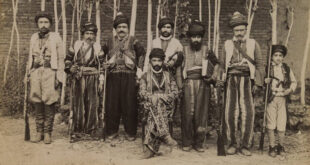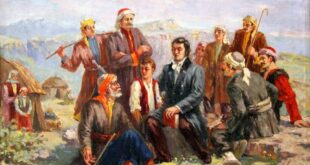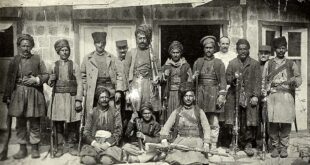Modern history of Kurdistan
1918: Sheikh Mahmoud Barzinji becomes governor of Suleimaniah under British rule. He and other Kurdish leaders who want Kurdistan to be ruled independently of Baghdad rebel against the British. He is defeated a year later. [1]
1923: The Treaty of Lausanne between Turkey and the allied powers invalidates the Treaty of Sevres, which had provided for the creation of a Kurdish state. [2]
1925: After sending a fact-finding committee to Mosul province, the League of Nations decides that it will be part of Iraq, on condition that the UK hold the mandate for Iraq for another 25 years to assure the autonomy of the Kurdish population. The following year Turkey and Britain signed a treaty in line with the League of Nation’s decision. [3]
1961: Mulla Mustafa Barzani’s requests for Kurdish autonomy were refused by the Iraqi government of Abdul Karim Qasim. On 11 September, Mustafa Barzani issued a proclamation to all Kurds to take up arms against the forces of hte Iraqi government, starting the Kurdish revolution. [4]
1970: The Kurdistan Democratic Party, lead by Mustafa Barzani, reaches an agreement with Baghdad on autonomy for Kurdistan and political representation in the Baghdad government. By 1974, key parts of the agreement are not fulfilled, leading to disputes. [5]
1971-1980: The Iraqi government expels more than 200,000 Faili (Shia) Kurds from Iraq. [6]
1975: The Iraqi government signs the Algiers Agreement with Iran, in which they settle land disputes in exchange for Iran ending its support of the Kurdistan Democratic Party and other concessions. [7]
1983: The Iraqi government disappears 8,000 boys and men from the Barzani clan. In 2005, 500 of them are found in mass graves near Iraq’s border with Saudi Arabia, hundreds of kilometres from the Kurdistan Region. [8]
1987-1989: The Iraqi government carries out the genocidal Anfal campaign against Kurdistan’s civilians, of mass summary executions and disappearances, widespread use of chemical weapons, destruction of some 2,000 villages and of the rural economy and infrastructure. An estimated 180,000 are killed in the campaign. [9]
1988: On 16 and 17 March 1988, Iraqi government airplanes drop chemical weapons on the town of Halabja. Between 4,000 and 5,000 people, almost all civilians, are killed. [10]
1991: The people in Kurdistan rise up against the Iraqi government days after the Gulf War ceasefire. Within weeks the Iraqi military and helicopters suppress the uprising. Tens of thousands of people flee to the mountains, causing a humanitarian crisis. The US, Britain and France declare a no-fly zone at the 36th parallel and refugees return. Months later, Saddam Hussein withdraws the Iraqi Army and his administration, and imposes an internal blockade on Kurdistan.
1992: The Iraqi Kurdistan Front, an alliance of political parties, holds parliamentary and presidential elections and establishes the Kurdistan Regional Government.
1994: Power-sharing arrangements between the Kurdistan Democratic Party (KDP) and the Patriotic Union of Kurdistan (PUK) fall apart, leading to civil war and two separate administrations, in Erbil and Suleimaniah respectively.
1998: The PUK and KDP sign the Washington Agreement, ending the civil war.
2003: The Peshmerga, Kurdistan’s official armed forces, fight alongside the coalition to liberate Iraq from Saddam Hussein’s rule.
2005: In a national referendum, Iraqis vote in favour of a new constitution. The new constitution, which is approved by 78% of voters, recognises the Kurdistan Region’s institutions including the Kurdistan Regional Government and the Kurdistan Parliament.
2006: At the start of the year, the PUK
and KDP agree to unify the two administrations. On 7th May, Prime Minister Nechirvan Barzani announces a new unified cabinet.
Reference
[1] Gareth Stansfield, ‘The Kurdish Question in Iraq, 1914-1974’, The Middle East Online Series 2: Iraq 1914-1974, Thomson Learning EMEA Ltd, Reading, 2006.
[2] Library of Congress Country Study: Iraq.
[3] Northedge, F. S. . The League of Nations: Its Life and Times, 1920-1946 Holmes & Meier. 1986
[4] Gareth Stansfield, ‘The Kurdish Question in Iraq, 1914-1974’, The Middle East Online Series 2: Iraq 1914-1974, Thomson Learning EMEA Ltd, Reading, 2006.
[5] No Friends but the Mountains: The Tragic History of the Kurds. John Bulloch and Harvey Morris.
[6] Human Rights Watch report, Whatever happened to the Kurds? 11 March 1991.
[7] David McDowall, A Modern History of the Kurds.
[8] Saddam’s Road to Hell: Documentary film by Gwynne Roberts.
[9] Kurdistan Regional Government estimate. Genocide in Iraq: The Anfal Campaign against the Kurds. Middle East Watch Report, Human Rights Watch, 1993.
[10] Human Rights Watch report, Whatever happened to the Kurds? 11 March 1991
 History of Kurdistan
History of Kurdistan



